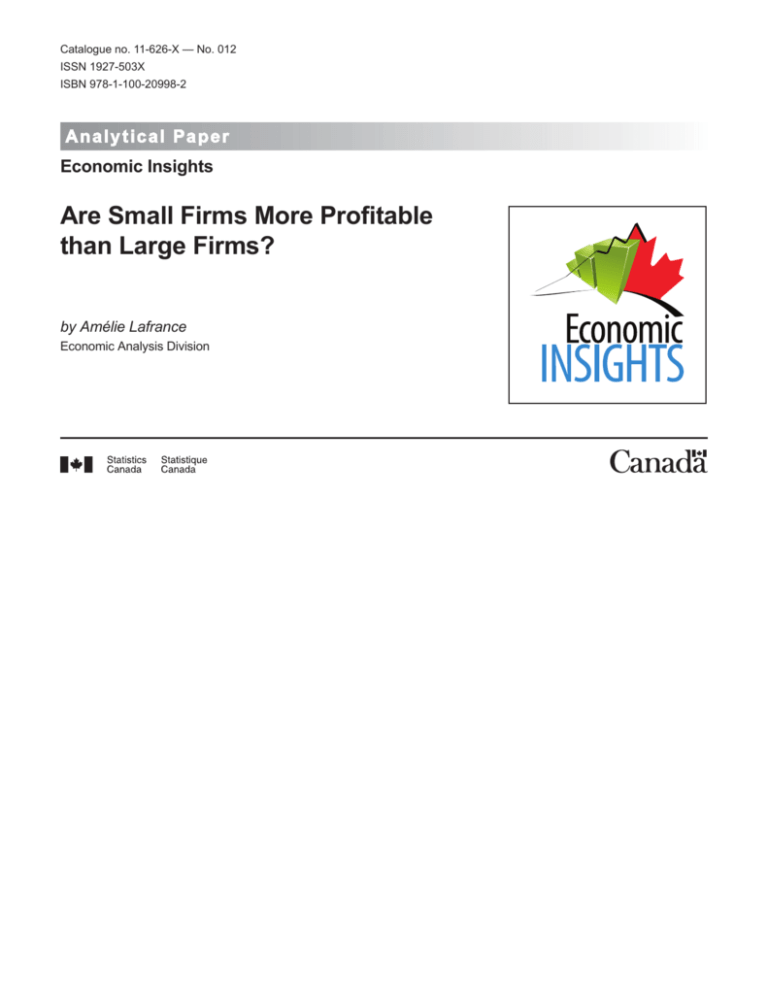
Catalogue no. 11‑626‑X ­— No. 012
ISSN 1927-503X
ISBN 978‑1‑100‑20998-2
A naly t ic al Pa p e r
Economic Insights
Are Small Firms More Profitable
than Large Firms?
by Amélie Lafrance
Economic Analysis Division
How to obtain more information
For information about this product or the wide range of services and data available from Statistics Canada, visit our website,
www.statcan.gc.ca, email us at infostats@statcan.gc.ca, or telephone us, Monday to Friday from 8:30 a.m. to 4:30 p.m., at the
following numbers:
Statistics Canada’s National Contact Centre
Toll-free telephone (Canada and United States):
Inquiries line
National telecommunications device for the hearing impaired
Fax line
1-800-263-1136
1-800-363-7629
1-877-287-4369
Local or international calls:
Inquiries line
Fax line
1-613-951-8116
1-613-951-0581
Depository Services Program
Inquiries line
Fax line
1-800-635-7943
1-800-565-7757
To access this product
This product, Catalogue no. 11-626-X, is available free in electronic format. To obtain a single issue, visit our website,
www.statcan.gc.ca, and browse by “Key resource” > “Publications.”
Standards of service to the public
Statistics Canada is committed to serving its clients in a prompt, reliable and courteous manner. To this end, Statistics Canada
has developed standards of service that its employees observe. To obtain a copy of these service standards, please contact
Statistics Canada toll-free at 1-800-263-1136. The service standards are also published on www.statcan.gc.ca under “About us” >
“The agency” > “Providing services to Canadians.”
Published by authority of the Minister responsible for
Statistics Canada
© Minister of Industry, 2012
All rights reserved. Use of this publication is governed by the
Statistics Canada Open Licence Agreement (http://www.
statcan.gc.ca/reference/copyright-droit-auteur-eng.htm).
Cette publication est aussi disponible en français.
Note of appreciation
Canada owes the success of its statistical system to a
long‑standing partnership between Statistics Canada, the
citizens of Canada, its businesses, governments and other
institutions. Accurate and timely statistical information could not
be produced without their continued co‑operation and goodwill.
Standard symbols
The following symbols are used in Statistics Canada
publications:
.
..
...
0
0s
not available for any reference period
not available for a specific reference period
not applicable
true zero or a value rounded to zero
value rounded to 0 (zero) where there is a meaningful
distinction between true zero and the value that was
rounded
p
preliminary
r
revised
x suppressed to meet the confidentiality requirements of the
Statistics Act
E
use with caution
F too unreliable to be published
* significantly different from reference category (p < 0.05)
Economic Insights, no. 012, July 2012 • Statistics Canada, Catalogue no. 11-626-X
ECONOMICINSIGHTS 1
Are Small Firms More Profitable than Large Firms?
APERÇUS ÉCONOMIQUES
Are Small Firms More Profitable than
Large Firms?
INSIGHTS
INSIGHTS
Economic
Economic
By Amélie Lafrance
This article in the Economic Insights series looks at the relationship between firm size and financial
performance. It highlights
APERÇUS
APERÇUS the
results from the research paper Firm Dynamics: Variation in Profitability Across Canadian Firms
of Different Sizes,Économiques
2000 to 2009.
Économiques
The research paper uses a special longitudinal database that follows corporate entities. It is part of a set of research projects being
carried out at Statistics Canada on the topic of business dynamics.
I
n the last decade, small businesses have attracted attention, as they are
often seen as innovators and job creators. The job and output growth, and
contribution to the economy of this group of firms are often compared with those
of larger businesses. However, there is little information in Canada on the payoff
to small firms for attempting to innovate. Firm performance in Canada has not
been comprehensively examined by means of certain financial metrics. This has
resulted in a significant information gap because financial performance relates
directly to the incentives that entrepreneurs face and the risks undertaken by those
who finance firms.
Measuring financial performance
Financial performance across firms of different sizes is examined
by using profitability, as measured by return on assets (ROA).
ROA is defined as earnings before interest and taxes, divided
by total assets. ROA gives an indication of how effectively a
company turns its assets into profit. The higher the ROA, the
higher the payoff.
As firms increase their workforce and reduce their operating
costs, their profits are expected to rise, albeit to a certain
threshold. As a result, one might expect a positive relationship
between profit rates and firm size, at least for smaller firms.
What the relationship is between size and profitability beyond
this threshold has long been a matter of speculation.
Medium-sized firms are the most profitable
Over the 2000 to 2009 period, average profitability was found
to follow an inverted U-shaped curve across size classes. As firm
size increased, ROA first increased, then reached a plateau, and
subsequently decreased. This pattern held over the entire period.
The firms with the highest ROA were those of relatively small
firms with 5-to-fewer-than-20 employees (Chart 1). The ROA
for these firms was just under 7% in 2000 and 8% in 2009.
All firm size classes, except the 500-or-more-employee class,
saw increases in ROA during the period. The largest increase
was experienced by firms with 50-to-less-than-100 employees.
Chart 1
Mean return on assets by firm size class
ROA (percent)
8.5
2000
2009
Average (all years)
8.0
7.5
7.0
6.5
6.0
5.5
5.0
4.5
1 to
<5
5 to
< 10
10 to
< 20
20 to
< 50
Firm size
50 to
< 100
100 to
< 500
500
and over
Source: Statistics Canada, author’s calculations.
In 2009, firms with 500-or-more employees were the least
profitable, showing lower rates of return than in 2000.
2
ECONOMICINSIGHTS
Economic Insights, no. 012, July 2012 • Statistics Canada, Catalogue no. 11-626-X
Are Small Firms More Profitable than Large Firms?
APERÇUS ÉCONOMIQUES
Risk and return
One of the factors behind differences in profitability and firm
size may be differences in risk. Risk in raising capital is often
associated with volatility, and a large body of work shows that
Economic
Economic
rates of employment
to be more volatile in smaller
INSIGHTS growth tend
INSIGHTS
firms. This could be because smaller firms seek out more risk
in order to attain higher rates of return. It may also be that
smaller firms’ production structures are more diverse and that,
therefore, APERÇUS
profitability is more APERÇUS
variable across firms in that
Économiques
Économiques
class. This
may occur with younger
firms in the early stages
of operation, when experimentation with new products and
processes is taking place. By contrast, larger firms are older and
may have similar production technologies that focus to a greater
extent on economies of scale and that therefore produce more
homogeneous results.
Volatility within a firm size class is measured by using the
coefficient of variation (CV), which is calculated as the variance
in ROA of different firms within a size class, divided by the
mean ROA of firms in that size class. The CV of profit rates
of firms within a size class ranged between 2.4% and 3.4% over
the period (Chart 2). In 2000 and 2009, the smallest firms
(those with fewer than 5 employees) had the highest CV. The
diversity of profit rates among firms in a size class was inversely
correlated with size for smaller firms. The CV curve decreased
with firm size until the 20-to-fewer-than-50-employees group,
which is also the range in which firms were most profitable. It
then increases slightly for the largest size classes. Nevertheless,
the smallest firms exhibit the most intra-group variance. These
results provide evidence that, as small firms grow, their financial
performance becomes more homogeneous—though this trend
reverses itself for very large firms.
Chart 2
Volatility of return on assets within a size class
Volatility (percent)
3.8
2000
2009
All years
3.6
3.4
3.2
3.0
2.8
2.6
2.4
2.2
1 to
<5
5 to
< 10
10 to
< 20
20 to
< 50
Firm size
50 to
< 100
100 to
< 500
Source: Statistics Canada, author’s calculations.
Are small firms more profitable?
Profitability varies in a consistent way across firms during the
post-2000 period. Profitability gradually increases until it reaches
a maximum in the class of firms with 5-to-fewer-than-20
employees. After this maximum has been reached, profitability
consistently falls. Smaller firms also experience a much more
diverse pattern: they exhibit larger variance in outcomes and
generally more intertemporal variation.
References
This article in the Economic Insights series is based on research carried out by the Economic Analysis Division. For more
information, see:
Lafrance, A. Firm Dynamics: Variation in Profitability Across Canadian Firms
of Different Sizes, 2000 to 2009. Statistics Canada Catalogue no. 11-622-M.
Ottawa, Ontario. The Canadian Economy in Transition. No. 026.
500
and over










